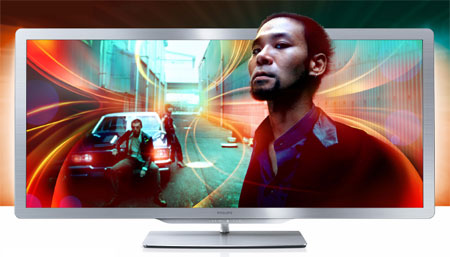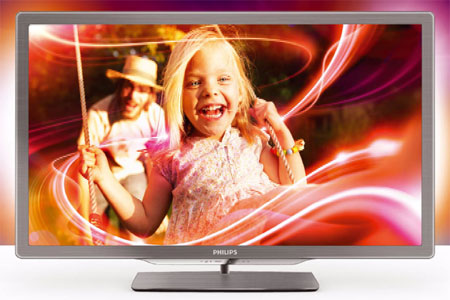Philips has unveiled its 2011 lineup of HDTV displays at the company’s annual product launch event in Barcelona today. In addition to active-shutter models, the Dutch conglomerate is going to offer passive 3D TV sets for the first time, following in the footsteps of Korean TV maker LG Electronics who unleashed its 3D LCD TVs equipped with FPR (film-type patterned retarder) technology on the unsuspecting television industry late last year.
Sporting what the company calls the “Easy 3D” technology, these Philips passive 3D televisions allow viewers to use polarized 3D glasses which are typically cheaper, lighter and more comfortable to wear than their active-shutter counterparts. These Easy 3D models are also meant to provide the “most comfortable” 3D viewing experience, presumably as a result of reduced flicker which lessens eye strain and fatigue.
Philips 50PFL7956 / Cinema 21:9 Gold Series
The passive “Easy 3D” display technology will be implemented on two lines of Philips 3DTVs. The first is the Cinema 21:9 Gold series, reaffirming the Amsterdam-based manufacturer’s commitment to continue making HDTVs with CinemaScope ultra-widescreen aspect ratio. Also known by its model number of 50PFL7956K/02, the 50-inch 21:9 3D TV will be equipped with edge LED backlight, 100Hz Clear LCD motion, Ambilight Spectra 2 bias lighting (on both sides of the flat-screen television) technology, and also the company’s new “Smart TV” internet-connected platform.

Besides its native 3D capabilities, the Philips 50PFL7956 can also perform 2D-to-3D conversion on the fly, and be used for two-player full-screen gaming (i.e. each player will be able to utilise the entire screen real estate to play a 2D game simultaneously by wearing the polarized glasses). Other features include Pixel Precise HD video processing engine, integrated wifi connectivity, USB recording and Multi-view (essentially picture-and-picture/PaP and picture-in-picture/PiP) functionalities.
42PFL7606 / 7606 Series

The other range of Philips LED TV to boast the passive “Easy 3D” technology is the 7606 series blessed with edge LED backlighting, Ambilight Spectra 2, 100Hz Clear LCD, Pixel Precise HD engine and Smart TV portal. Five screen sizes are available: the 32-inch 32PFL7606, the 37-inch 37PFL7606, the 42-inch 42PFL7606, the 47-inch 47PFL7606 and the 55-inch 55PFL7606. UK pricing and release dates remain unknown at this point of writing.

They new 21:9 looks great. I have the first one with the three sided Ambilight and it looks amazing on the wall.
I do question the use of 21:9 in presenting 3D content though.
Avatar, Tangled, most of the other 3D films are presented in 16:9.
Hi Paul,
Thanks for your comment.
To be clear, films are shot in 21:9 and then letterboxed into a 16:9 format…..the Cinema 21:9 TV auto formats the content to fit the entire screen of this TV so you can enjoy content – 3D or otherwise just as you would at the cinema and as the film director intended.
Philips
I want one of these now – where did mr cathcart get his! seriously I thought the only problem with the first generation was its size – not wrong just can’t fit into my place – going down to a 50 inch works for me – and added to that the passive 3d and LED backlight its a no brainer – been running my pc through my HDTV for ages so not that bothered about smarthub – though happy to be surprised, and last the gaming feature is genius – though I suspect it is limited to 2 players?
When will the new 7000 series be available?
From what I understand, the 55 inch 6606 does not come with ambilight so think I will wait for the 55 inch 7606 to be released. In addition, do you have more information about which features that separate these two models in terms of functionality and picture quality?
Edge lit? So that means uneven backlight/clouding then? What a shame as the 21:9 is a very interesting format.
I have read many reviews of passive 3D TVs (mainly LG’s new offerings to be honest) and the passive format cries out to me. As a prescription spectacle wearer, Active Shutter is impractical and that’s not even considering the cost of the 3D glasses.
However like most new technology, the problems with both formats seem to be evident and known but none of the manufacturers seem to want to address them (or perhaps its just impractical cost-wise).
Take LG’s latest 55inch monster.(the LG 55LW650T) which was reviewed on http://www.trustedreviews.com. An excellent launch price (and the cheap glasses) was the first thing that attracted me to this TV until I read the review. I can accept that the picture quality may not be quite up to the resolution you can get with active 3D but why the pronounced backlighting problems and under-par sound quaity?
Surely backlighting issues could be fixed by using full-LED backlighting instead of edge-LED backlighting or am I missing something here?
LG 42lw650s VS PHILIPS 42PFL7606
I went and saw the LG and I liked the Passive 3D image.
I understand that both panels are made by LG.
But what about the electronics.
Which is better for normal TV (non 3D) viewing.
Thanks